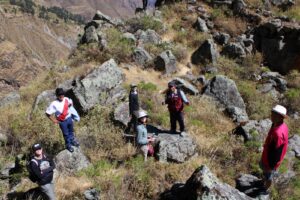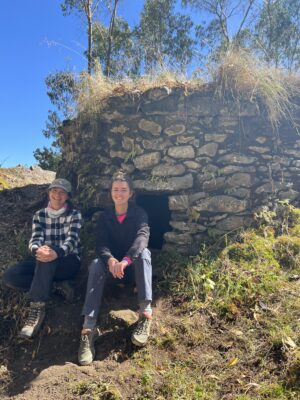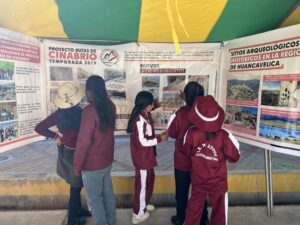Michelle Young: Modeling ethical practices in Peruvian archaeology
By Ann Marie Deer Owens
When Vanderbilt archaeologist Michelle Young travels to the Peruvian Andes to study ancient Indigenous societies, her itinerary is filled with much more than field surveys and excavations. “I put a priority on forging local partnerships based on communication and mutual respect with the Quechua-speaking and mestizo (mixed Indigenous-European) communities in the central highlands of Peru,” said Young, assistant professor of anthropology. “I want to model how significant research can be conducted in ways that are ethical and beneficial to nearby communities.”

Since 2020, Young has directed the Cinnabar Roads Project, which explores ancient exchange routes used to transport cinnabar, a powdery mineral made of mercury and sulfur that was extracted and processed for pigment. Cinnabar was used widely as decorative red pigment on bone and wood objects as early as the second millennium B.C.E. There is also evidence of bodies being completely covered in cinnabar during ancient burials.
“We know that cinnabar was transported hundreds of miles between the Peruvian highland region and the coast during a time when travel would have been by foot with the support of pack animals,” Young said. “By studying trade routes developed for cinnabar across distant ecological zones, we can learn more about the economic and social organization of past societies.”
The largest known cinnabar mine, called Santa Bárbara, is in the Huancavelica region of Peru. The site that Young excavated for her dissertation research is 13 kilometers east of Santa Bárbara. “We found ample evidence for communities’ exploitation of cinnabar, with the probability of some level of processing and then exportation to other areas of Peru,” she said. “This sealed my interest in ancient economies, thinking about how people in small-scale societies organize themselves and acquire desired resources.”
Through Young’s studies, she also developed a strong interest in the role of the material world in the construction of individual and group identities in Indigenous communities. Young’s fascination with ancient objects began as an undergraduate at the University of Virginia, where she took her first anthropology course. “I realized how much there was to learn from artifacts—the stories embedded in the materiality of these older objects,” she said. “I loved being outside and the sense of adventure and discovery with archaeology, as well as the camaraderie in the field.” She received a bachelor’s degree in anthropology and history of art before enrolling at Yale University, where she earned a master’s and doctoral degree in anthropology.
From 2017 to 2019 she carried out mapping, survey, excavation, sample collection, and laboratory analyses of materials from Atalla, Peru, in collaboration with Peruvian and international students and scholars and local workers. Her project established a multi-year program of community outreach and education based in the town of Yauli. Her research has been supported by generous funding from the National Science Foundation, Fulbright, Smithsonian Institution, Dumbarton Oaks (a Harvard University trustee), and Rust Family Foundation.
In 2020 she was awarded a Smithsonian Institution Postdoctoral Fellowship at the National Museum of the American Indian, where her projects included a public-facing, richly illustrated booklet highlighting her research on the cinnabar pigment used to decorate ancient objects in the museum’s collection.
Young joined the Vanderbilt College of Arts and Science in 2022. Last summer she took two students—doctoral

candidate Sylvia Cheever and undergraduate Natalia Sawyer—to Peru for a month of field research.They also provided vital support for Young’s community outreach, with Sawyer handling social media updates on Instagram and Facebook @cinnabarroadsproject.
“We hosted hands-on didactic workshops and photographic exhibits for our Peruvian academic colleagues and the public,” Young said. “We also participated in radio and nationally televised interviews to disseminate information about our research. In addition, we donated almost 1,000 trilingual booklets to local communities, youth groups, and institutions.”
The trio’s field research would begin early each morning with visits to communities located near archaeological sites associated with natural movement corridors leading to the cinnabar deposits. “First, we made contact with local community members who were interested in sharing information, such as oral histories, about nearby archaeological sites,” Cheever said. “Many of the residents were excited about our research and accompanied us to sites they believed were most relevant to the local history. The goal of our survey was to identify archaeological sites connected to cinnabar exploitation. We hope that through studying these sites, we can understand how past societies found ways to leverage natural resources for community and individual benefit.“
Cheever said Young has been indispensable to her own doctoral studies. “Dr. Young has helped me build preliminary government and community connections in Peru that are absolutely crucial to a successful dissertation. I’m very grateful that she brought me on as a collaborator on this project in that respect,” Cheever said. “My research is also related to cinnabar, but I focus on mercury, which is a major component of cinnabar. I’m investigating mercury toxicity by measuring the levels of mercury stored in the bones of people who inhabited this area in the past. I hope to use these data to better understand historical impacts of mining on community health in the Huancavelica region over the past 3,000 years. I’m also interested in how we can use mercury levels and isotope ratios in human remains to talk more broadly about who was interacting with cinnabar most frequently in the past and why that might be.”

Young’s two major research initiatives approach mapping ancient networks of interaction and mobility between the highland region and the coast, employing a variety of methods at different scales. Under her leadership, the Cinnabar Roads Project has registered more than 100 archaeological sites in the Huancavelica region. In addition to leading the community engaged, field-based Cinnabar Roads Project, Young directs the lab-based Pre-Columbian Pigments Project, which focuses on developing new methodologies for identification and sourcing of pigments. Young identifies pigments using the portable X-ray fluorescence (pXRF) instrument housed in the Department of Anthropology. This technique uses X-rays to excite electrons in the analyzed material, which in turn produce characteristic energies that are measured by the instrument to infer elemental composition.
She also leads a multi-disciplinary team that is employing multi-collector inductively coupled plasma mass spectrometry (MC-ICP-MS), a technique used to separate and measure the proportion of elemental isotopes in a sample. Although MC-ICP-MS is becoming more common in archaeology, the application of this technique on mercury isotopes to identify the geochemical source(s) of archaeological cinnabar has not been well explored—until recently.
In 2025, a new study published in PLOS One and led by Young brought together 97 cinnabar specimens from Peru, 65 of which have never been published, to demonstrate that the geochemical method using mercury isotope systems is effective in identifying the geological source of archaeological pigments.
“This study represents a bold advance in the archaeological sciences,” Young said. “So, for example, when we find a sample of cinnabar on the very far north coast of Peru, we can determine whether it came from a particular mine. Historical records from this period do not exist, so our community-supported excavations—along with state-of-the-art technical analyses—provide a path to groundbreaking discoveries on the importance and meaning of this valued exchange material. The goal of such research is to uncover ancient Indigenous ways of doing and knowing that have been lost in time or overlooked by Western biases.”
